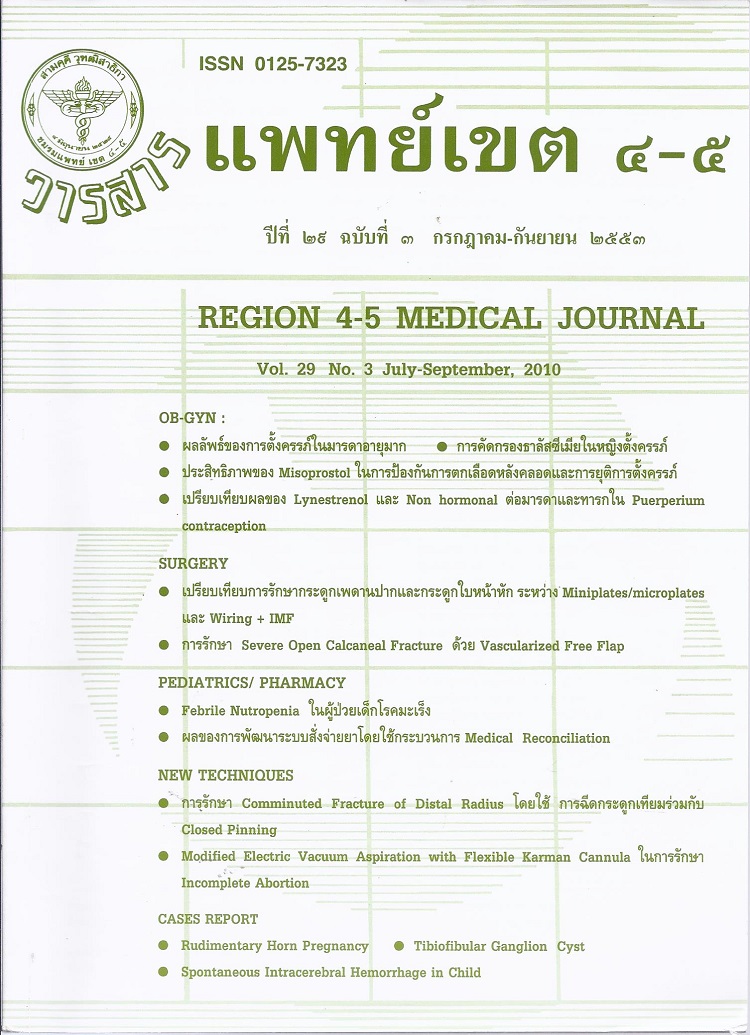เปรียบเทียบผลการรักษากระดูกเพดานปากหักระหว่างด้วยวิธีร้อยมัดลวดกับการใช้ Microplates/miniplates และ Screwป
บทคัดย่อ
Objectives
1. To study the etiology and pattern of the palatal fractures.
2. To compare the results between two modalities of treatment between wiring and IMF versus rigid open reduction and internal fixation (ORIF) with miniplates and screws for the palatal fractures.
Patients and Methods : From the evidence of 218 patients whom were diagnosed as maxillary fracture in Nakhonpathom hospital during 5 years from June 2005 - June 2010, twenty three consecutive cases of palatal fractures were prospectively studied in two surgical treatment modalities. They were divided into 2 groups of 15 and 8 patients respectively. Patients in group 1 were operated by ORIF with microplate/miniplate and screw technique, group 2 by wiring and IMF technique. Demographic characteristics including age, sex, etiology, type of palatal fracture and associated facial bone injuries were recorded and presented in terms of frequency and percentage. Parameters including operative time, intra-operative blood loss, postoperative nasal packing, intubation, tracheostomy, IMF period, length of stay in the intensive care unit (ICU), hospital length of stay, clinical follow - up and postoperative complications were compared among the groups using F-test for homogeneity of variance, t-test and chi-square.
Results : It was 21-30 age range, where majority of the patients confined to male proportion (86.96%) in this series. Main etiology of injuries (91.31%) were road traffic accidents ; of these 65.21% were motorcycle accidents following by car and truck 17.39% and 8.7% respectively; the rest 8.7%, the interpersonal violence was the cause. All cases presenting with palatal fractures had associated injuries to various craniofacial bones and involved many fracture patterns. Le Fort 2 was the most common fracture pattern in 60.87% and fracture mandible 52.17%, while 34.78% belonged to panfacial fracture. The most frequent palatal fracture classification was type 1 : sagittal in 82.6%, while type 2 : transverse and type 3: comminuted were at 8.7% each. There were no significant differences among both groups regarding intraoperative blood loss, postoperative nasal packing, tracheostomy, postoperative intubation period (except at first day), ICU stay, hospital stay and malocclusion or fracture instability. The operative time in the first group was significantly longer than in the second group, whereas the IMF period, incidence of midfacial retrusion, TMJ ankylosis and type-C tympanogram were significantly higher in the second group than in the first group.
Conclusions : In high-velocity impact injuries, the palatal fractures usually has severe associated skull and facial bone injuries. The key elements in our treatment plan consist of multidisciplinary team approach, well demonstration of the entire fracture sites, rigid stabilization of the buttresses including the palatal vault and reduced length of IMF duration.
ดาวน์โหลด
เผยแพร่แล้ว
รูปแบบการอ้างอิง
ฉบับ
ประเภทบทความ
สัญญาอนุญาต
ลิขสิทธิ์บทความเป็นของผู้เขียนบทความ แต่หากผลงานของท่านได้รับการพิจารณาตีพิมพ์ลงวารสารแพทย์เขต 4-5 จะคงไว้ซึ่งสิทธิ์ในการตีพิมพ์ครั้งแรกด้วยเหตุที่บทความจะปรากฎในวารสารที่เข้าถึงได้ จึงอนุญาตให้นำบทความในวารสารไปใช้ประโยชน์ได้ในเชิงวิชาการโดยจำเป็นต้องมีการอ้างอิงถึงชื่อวารสารอย่างถูกต้อง แต่ไม่อนุญาตให้นำไปใช้ในเชิงพาณิชย์




